Virus Diseases in Dahlias
Dahlias are like people, susceptible to diseases that cause as many ill effects as us having a good dose of the flu. Everyone feels and looks very sick!! We hear the phrase “ Oh its virused, just throw it out “ but what does this mean.
First of all what is a virus?
Viruses are small amounts of nuclear material wrapped in a thin coat of protein , that cause disease There are many different kinds of viruses, but all are too small to be seen without the aid of a very powerful electron microscope capable of magnifying more than 1000 times the actual size. Viruses enter and take control of the cells of the host ( that is the dahlias or you and me ) and are able to direct these cells to make more viruses, until just within a few days millions of virus particles are produced per infected cell. As the host cells divide they carry the virus inside them ( You can see that this becomes important when dividing up your tubers . We do not want to pass on any infected material from one plant to another. ) Viruses are parasites, completely dependent on their hosts for reproduction and have developed efficient and specific ways to move within a plant and spread between plants by inter acting with vectors ( aphids, tools ) , to ensure their survival. Although there are hundreds of viruses that infect plants only about a dozen have been reported to infect dahlias, and only a few are commonly found.
How can we tell which virus it is?
Normally they are identified by their shape, size and type of genetic material, as well as other sophisticated tests e.g. serology , that needs to be done in a laboratory. In humans it is important to know these things as then something can be done about the spread, and maybe a vaccine can be developed. In dahlias however I doubt that many growers will go to this level of expense, although the Dr Hanu Pappu in conjunction with the American Dahlia Society has researched this topic which can be accessed at Washington State University
I would like to thank both Dr Pappu and Dr Keith Hammet who have provided information and photos for this article.
What do virus diseases look like?
Viruses can cause a wide range of symptoms and damage. Symptoms include occasional yellow spots or blotches, mosaic, vein yellowing, yellow line patterns, leaf margin yellowing and necrosis. Plants and roots may be stunted, deformed in shape, leaves may role or cup and blossoms and tubers may be suppressed in size and number. Often virus symptoms can be confused with mineral deficiencies, other cultural problems or insect damage. The most common symptoms are mosaics, patches of dark green and light green on the leaves. Flat leaves in general indicate healthy plants while those with twisted leaves(epinasty) are likely to be infected
How are viruses spread?
Virus infected plants and tubers represent the major source of infection to dahlia cultivation. As the tubers are cut the virus is transferred to the cutting blade and then onto fresh material if the blade is not cleaned. A cheap and successful way of sterilizing blades, etc is to have several and dip them into a solution of bleach between each cutting. If you grow cuttings these cuttings will also be infected as the virus is present inside the plant cells. The virus is not passed on by healthy plants touching infected plants, a wound must be present for transfer of material. Aphids and other insects by their actions wound the plant and pass on the virus from one plant to another.( this is why a good spray programme is so important. ) Debranching, disbudding and cutting all provide wound entry points for viruses. Good hygiene is important, wash hands frequently and ensure tools are clean. Once a plant is infected it cannot be cured of virus infection. The only way to control plant viruses is to avoid virus introduction and prevent spread. So the safest way is to “ just throw it out “

Virus Shapes
|
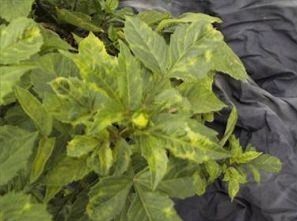
Overall Appearance of virused plant
|

Epinasty or Twisting of leaves
|
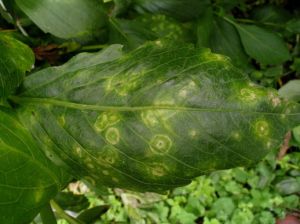
Virus symptoms causing leaf spots in Kiwi Gloria
|
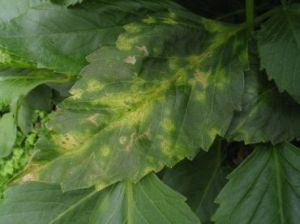
Te Kuiti Virus
|
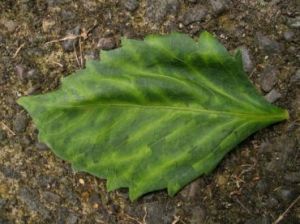
A leaf of Taratahi Ruby showing symptoms of virus
|
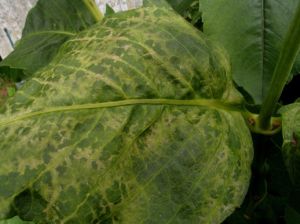
Virus signs on leaf of White Charlie Two
|

More signs of virus
|
Photos supplied courtesy of Keith Hammett and Hanu Pappu









